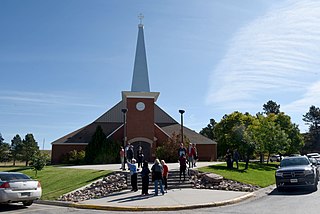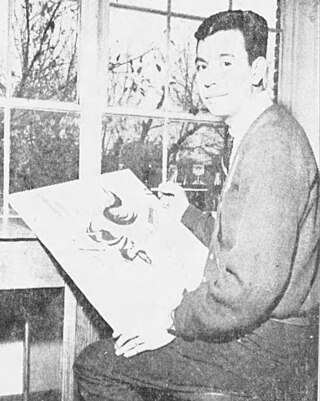
The Lakota are a Native American people. Also known as the Teton Sioux, they are one of the three prominent subcultures of the Sioux people, with the Eastern Dakota (Santee) and Western Dakota (Wičhíyena). Their current lands are in North and South Dakota. They speak Lakȟótiyapi—the Lakota language, the westernmost of three closely related languages that belong to the Siouan language family.

The Sioux or Oceti Sakowin are groups of Native American tribes and First Nations people from the Great Plains of North America. The Sioux have two major linguistic divisions: the Dakota and Lakota peoples. Collectively, they are the Očhéthi Šakówiŋ, or "Seven Council Fires". The term "Sioux", an exonym from a French transcription ("Nadouessioux") of the Ojibwe term "Nadowessi", can refer to any ethnic group within the Great Sioux Nation or to any of the nation's many language dialects.

Oglala Lakota County is a county in southwestern South Dakota, United States. As of the 2020 census, the population was 13,672. Oglala Lakota County does not have a functioning county seat; Hot Springs in neighboring Fall River County serves as its administrative center. The county was created as a part of the Dakota Territory in 1875, although it remains unorganized. Its largest community is Pine Ridge.

Pine Ridge is a census-designated place (CDP) and the most populous community in Oglala Lakota County, South Dakota, United States. The population was 3,138 at the 2020 census. It is the tribal headquarters of the Oglala Sioux Tribe on the Pine Ridge Indian Reservation.

Crazy Horse was a Lakota war leader of the Oglala band in the 19th century. He took up arms against the United States federal government to fight against encroachment by White American settlers on Native American territory and to preserve the traditional way of life of the Lakota people. His participation in several famous battles of the Black Hills War on the northern Great Plains, among them the Fetterman Fight in 1866, in which he acted as a decoy, and the Battle of the Little Bighorn in 1876, in which he led a war party to victory, earned him great respect from both his enemies and his own people.

American Horse was an Oglala Lakota chief, statesman, educator and historian. American Horse is notable in American history as a U.S. Army Indian Scout and a progressive Oglala Lakota leader who promoted friendly associations with whites and education for his people. American Horse opposed Crazy Horse during the Great Sioux War of 1876–1877 and the Ghost Dance Movement of 1890, and was a Lakota delegate to Washington. American Horse was one of the first Wild Westers with Buffalo Bill's Wild West and a supporter of the Carlisle Indian Industrial School. His record as a councilor of his people and his policy in the new situation that confronted them was manly and consistent and he was known for his eloquence.

The Institute of American Indian Arts (IAIA) is a public tribal land-grant college in Santa Fe, New Mexico, United States. The college focuses on Native American art. It operates the Museum of Contemporary Native Arts (MoCNA), which is housed in the historic Santa Fe Federal Building, a landmark Pueblo Revival building listed on the National Register of Historic Places as Federal Building. The museum houses the National Collection of Contemporary Indian Art, with more than 7,000 items.

Iron Tail was an Oglala Lakota Chief and a star performer with Buffalo Bill's Wild West. Iron Tail was one of the most famous Native American celebrities of the late 19th and early 20th centuries and a popular subject for professional photographers who circulated his image across the continents. Iron Tail is notable in American history for his distinctive profile on the Buffalo nickel or Indian Head nickel of 1913 to 1938.

Moving Robe Woman, also known as Mary Crawler, Her Eagle Robe, She Walks With Her Shawl, Walking Blanket Woman, Moves Robe Woman, Walks With Her Robe and Tashenamani was a Hunkpapa Sioux woman who fought against General George Custer during the Battle of Little Big Horn to avenge her brother, One Hawk, who had been killed.

The Oglala are one of the seven subtribes of the Lakota people who, along with the Dakota, make up the Očhéthi Šakówiŋ. A majority of the Oglala live on the Pine Ridge Indian Reservation in South Dakota, the eighth-largest Native American reservation in the United States.

Ledger art is narrative drawing or painting on paper or cloth, predominantly practiced by Plains Indian, but also from the Plateau and Great Basin. Ledger art flourished primarily from the 1860s to the 1920s. A revival of ledger art began in the 1960s and 1970s. The term comes from the accounting ledger books that were a common source of paper for Plains Indians during the late 19th century.

Arthur Douglas Amiotte is an Oglala Lakota Native American painter, collage artist, educator, and author.

Plains hide painting is a traditional North American Plains Indian artistic practice of painting on either tanned or raw animal hides. Tipis, tipi liners, shields, parfleches, robes, clothing, drums, and winter counts could all be painted.

Red Cloud Indian School is a private, Catholic, K–12 school run by the Jesuits in Oglala Lakota County, South Dakota. It is located in the Diocese of Rapid City and serves Oglala Lakota Native American children on the Pine Ridge Indian Reservation.

Wild Westing was the term used by Native Americans for their performing with Buffalo Bill's Wild West and similar shows. Between 1887 and World War I, over 1,000 Native Americans went "Wild Westing." Most were Oglala Lakota from their reservation in Pine Ridge, South Dakota, the first Lakota people to perform in these shows. During a time when the Bureau of Indian Affairs was intent on promoting Native assimilation, William Frederick Cody used his influence with U.S. government officials to secure Native American performers for his Wild West. Cody treated Native American employees as equals with white cowboys.

Alice Blue Legs was a Lakota Sioux craftworker, notable for her quillwork. She received a 1985 National Heritage Fellowship from the National Endowment for the Arts and was a featured artist for the documentary film Lakota Quillwork—Art and Legend. Her work was seen in the epic film Dances with Wolves and exhibited in museums such as The Children's Museum of Indianapolis, the Heard Museum, the Sioux Indian Museum. Examples of her work are in the permanent collection of the Indian Arts and Crafts Board at the Washington, D. C. headquarters of the United States Department of the Interior and the Smithsonian's National Museum of the American Indian.
The Wounded Knee 4-Directions Toby Eagle Bull Memorial Skatepark, also known as the Toby Eagle Bull Memorial Wounded Knee Four Directions Skate Park & the WK4-Directions TEB Memorial Skatepark, is a concrete skatepark located in Pine Ridge, South Dakota, United States, on the Pine Ridge Indian Reservation. Completed in 2011 by the local community with help from skateboarding organizations, the skatepark features a spectrum of skate obstacles and is dedicated to a young Lakota skater who died in a car accident: Toby Eagle Bull. The WK4D TOB Memorial Skatepark is located in the Youth Opportunity, or "YO," park, adjacent to the Oglala Lakota Nation powwow grounds, a picnic area, a playground, a basketball court as well as a baseball field.
Peri Pourier is an American politician, serving as a member of the South Dakota House of Representatives from the 27th district since 2019, as a Democrat. Prior to entering politics, she worked as a background investigator. As of 2022 her official profile listed her occupation as “small business owner”. Pourier is a member of the Oglala tribal group and lives in Pine Ridge, South Dakota.
Walt Pourier is an American skateboarder, artist, designer, and skateboarding activist. Pourier is Oglala Lakota.

Kevin Pourier is an Oglala-Lakota artist known for buffalo horn fabrications. He works with his wife Valerie Pourier. They are located at the Pine Ridge Reservation in South Dakota. The couple create wearable art from carved buffalo horn.
















